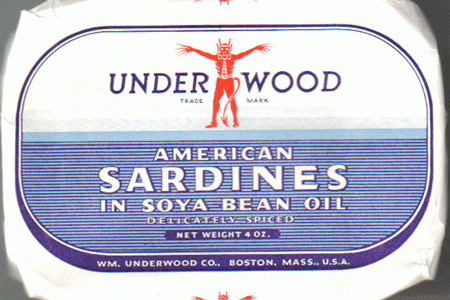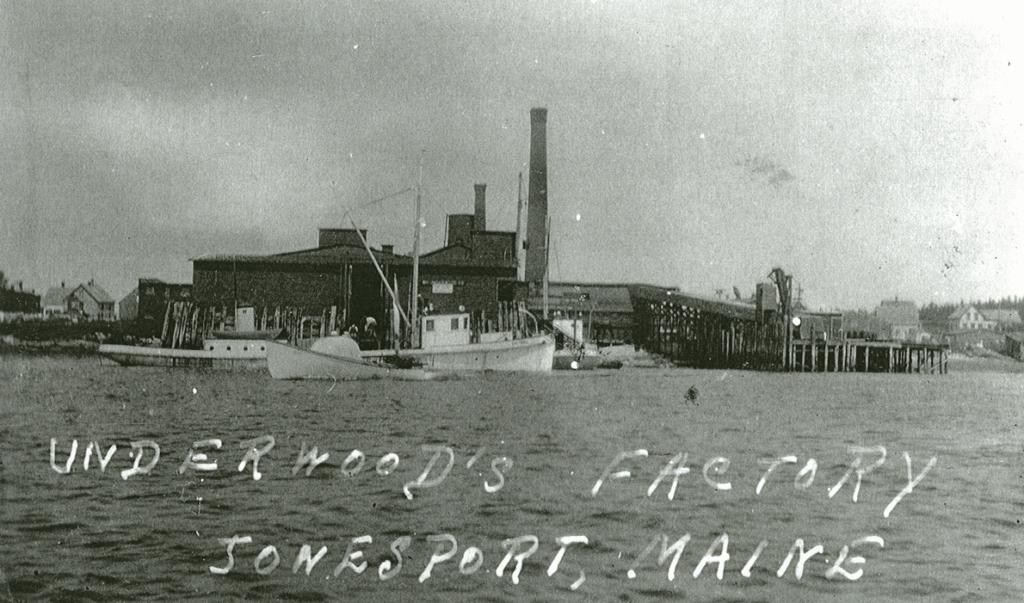The old labels tell a story.
A lion leaps across Mansfield Packing Co.’s Golden Lion branded can of French-style sardines. A devil with spiked tail and, oddly, tie and lapels spreads arms over Wm. Underwood & Co.’s sardines in tomato sauce. A schooner sails by a pennant boasting of Three Rivers Co.’s salt-cured herring.
The great era of Maine’s canneries also embraced great graphic arts. Sardines—juvenile herring possibly named after Sardinia—were the primary product. But Atlantic herring are migratory, traveling between Labrador and Virginia and available inshore only during warmer months. Many factories took up slack by packing products like clams and lobsters.
Herring is a hot topic these days. They’re a linchpin species that feeds marine mammals, larger fish, and seabirds. They’re important bait for fisheries like lobster and tuna. They supported a century-long canning industry.
But a new stock assessment shows that although herring is not overfished, juvenile numbers have declined in recent years. As scientists study potential reasons, regulators consider further fishery limits, and stakeholders disagree about resource abundance, they all agree that the little fish play a huge role in the ocean’s health.
Jonesport Historical Society Vice President Charles Alley recalled when weirs and stop-seines were packed with herring. Factories blew their whistles to call employees to work. Women graded fish by size, cut off heads and tails, and laid them in cans in neat rows to the tune of clattering machinery. Lobster fishermen coveted the cuttings to use as bait.
“They could cut the heads off those herring so fast,” Alley said of the women.
Sardines were an important, inexpensive protein; Maine’s factories were an important food source for overseas troops during World War II. Alley recalled Underwood would sell imperfect cans to the locals for a nickel.
“We’d open up the sardines and have it with fried potatoes,” he said.
Canning began in the early 19thcentury, thanks to a French scientist’s discovery of food sterilization techniques. The Second Century,published in 1927 and available at the historical society, says Underwood implemented the process in tin canisters. In 1880, the Underwood family built a large, modern plant in West Jonesport to can sardines, clams, lobsters, and other products. That was the start of numerous plants along the coast established by Underwood and other companies. Jonesport had 15 plants during its peak. In 1926, Underwood put out 11.75 million cans of sardines, containing an estimated 107 million fish. Yet Underwood was only a tenth of total sardine production.
FOOD OF CHOICE
Herring’s ecosystem role was recognized at that time. As the author wrote, the quantity of canned sardines was just a fraction of “the hordes devoured by cod, haddock, dogfish, hake, pollock, seal, and other natural predators.” Even then, fishermen saw annual resource fluctuations, yet “no visible falling off in the supply as a whole.”
Landings were harvested by weirs and stop-seines—stationary nets that trap herring entering coves and bays—and mobile gear called purse seines, carried by boat further offshore to encircle herring schools and “purse” them up.
Ernest Kelley of Jonesport, 91 and still hauling lobster traps, recalled fishing with his father in the 1940s.
“We’d use running twine and shut the cove off, then we’d put a pocket on and run them into the pocket and seine them out of that,” he explained. “Then we could sell it to any of the fish factories that was putting up sardines.”

Unerwood sardines
One cannery employed 500 people, he said. Most of Jonesport’s canneries had closed by the 1920s, leaving three operating in the 1960s. When the last one closed in 1973, that ended the local herring fishery, said Kelley.
For decades, smaller gear types brought in enough herring for food and bait. But trouble ensued. According to the New England Fishery Management Council, an aggressive foreign fishery developed on Georges Bank in the early 1960s; landings peaked at 1 billion pounds in 1968—10 times previous averages—and led to a collapse of the offshore stock. Regulations resulted in a rebound.
In the 1990s, new concerns emerged with the advent of industrial-scale trawlers. Up to 165 feet long, they’re the East Coast’s largest and most advanced fishing vessels, capable of holding more than 1 million pounds of fish, NEFMC says. Today, these “midwater trawlers” catch 68 percent of New England herring; purse seines catch 26 percent. Various regulations limit trawler operations and overall landings, and regulators say the stock is not overfished.
FEWER YOUNG
But a new situation has emerged. A 2018 assessment says the number of young herring has been unusually low in recent years. That’s causing concern about the resource’s future. Consequently, regulators are considering fishing quota cuts and further limitations on trawlers.
Still, opinions vary. Glenn Robbins, a long-time herring fisherman who runs a purse-seiner and is a herring advisor to the Atlantic States Marine Fisheries Commission, said quota should be decreased in some areas and trawlers should be banned from the fishery. But, he said, “The inshore fishery is OK. It’s not as good as I’d like to see it. But we’ve got lot of big fish that are spawning, and a lot of small fish that are growing up. So I’m not worried.”
Ben Martens, executive director of the Maine Coast Fishermen’s Association in Brunswick, said, overall, “We’re concerned about what’s happening to the resource, and what that means for other species in the Gulf of Maine that rely on herring as a food source. We’re trying to build back a lot of species from low points in their biomasses and they eat herring, and if there’s no herring in the ocean, that gets harder to do.”
“They don’t come like they used to,” agreed Alley, who grew up in Jonesport. “But herring are funny. Some years they might be solid and the next year there might not be any.”

LAURIE SCHREIBER
Jonesport Historical Society President Donald Woodward, Vice President Charles Alley, and Membership and Data Manager William Plaskon, at the society’s museum and heritage center.





